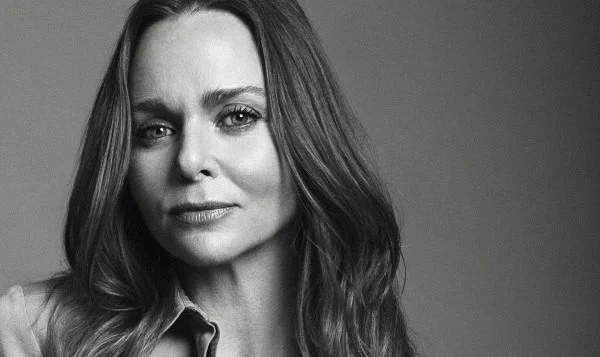CRUELTY-FREE FEATHERS AT STELLA MCCARTNEY
Growing Roots: How the Vegan Textile Industry is Blooming
The vegan textile world has entered a new phase: one marked by material innovation, market expansion, and high-fashion declarations that cruelty-free can also be luxurious. With consumer values shifting toward sustainability and ethics, textile makers, designers, and brands are responding - sometimes leading with ground-breaking solutions.
A High-Profile Moment: Stella McCartney & the Debut of “Fevvers”
For her Paris Fashion Week Spring/Summer 2026 collection, Stella McCartney made headlines by debuting Fevvers, a plant-based alternative to feathers. These cruelty-free feathers appeared in multiple key looks replacing traditional bird feathers in gowns and accessories, showcasing that even the most delicate, decorative textile elements can be re-imagined without animal harm. The collection was reportedly 98% sustainable and 100% cruelty-free, eliminating not just leather and fur, but also conventional feathers and exotic skins. It also featured an innovation called PURE.TECH, a fabric designed to absorb pollutants, adding functional environmental benefit beyond aesthetics. McCartney’s move underscores an important turning point: decorative and finishing materials often considered “extras” — are now being held to the same ethical and environmental scrutiny as the main fabrics. It signals that the industry’s benchmark for sustainability is rising.
Stella McCartney has been championing sustainable fashion since launching in 2001.
Industry Growth: Numbers & Trends
The vegan textile and vegan leather sectors are growing fast. The global vegan leather market is expected to have a compound annual growth rate of about 10.8% between 2025 and 2034, with market size projected to grow from 11.07 billion USD in 2025 to roughly 27.80 billion USD by 2034. The broader vegan clothing market is similarly scaling. Estimates suggest growth from under 1 billion USD in market value in 2025 to several billion by 2035, driven by ethical consumer trends, regulatory pressure, and innovations in material science. In parallel, fabric innovations like Savian (a plant-based alternative to fur or shearling), FLWRDWN (a down alternative made using wildflowers and bio-polymers), and others are pushing the boundaries of what plant-based textiles can achieve in texture, warmth, aesthetics, and environmental impact. Innovation & Supply Chain: What’s Changing Under the Surface
Several key innovations are helping the vegan textile industry mature from niche experiments to scalable, high-fashion standards:Alternative Decorative MaterialsAs with Fevvers, there is now more investment in replacing decorative leathers, feathers, fur etc., not just main apparel materials. These are traditionally high-visual-impact and symbolic of luxury, so replacing them with cruelty-free alternatives has both ethical and symbolic significance. Advanced Material Science & Bio-sourcingStart-ups and textile labs are working with plant-based sources (pineapple leaf fibre, mushrooms/mycelium, apple skins, etc.), agricultural by-products, and bio-polymers to create materials that mimic the look, feel, and sometimes functional properties (e.g. insulation, durability) of animal-derived materials. The goal is also to reduce environmental footprint (water, chemical use, energy) and improve biodegradability or recyclability. Supply Chain Transparency and CertificationsConsumers, regulators, and NGOs are pushing for traceability — knowing not just that a material is “vegan,” but how it was grown, harvested, processed, dyed, transported, treated, and disposed of or recycled. This includes concern over synthetic coatings, microplastics, and whether plant-based materials are processed in a way that undermines their ecological credentials.Demand & Regulatory PressureThere is rising consumer demand — especially among younger shoppers — for cruelty-free, ethically produced, and low-impact fashion. Regulations in some markets increasingly favour sustainable materials (tax incentives, bans on certain animal materials, etc.). Also, pledges and partnerships (e.g. brands signing feather- or fur-free pledges) are becoming more common. Stella McCartney for example had signed PETA’s Feather-Free Pledge. Looking Forward: Opportunities & Challenges
While momentum is strong, several challenges remain:Scalability and CostPlant-based decorative materials and alternatives often cost more (R&D, sourcing, small-batch production). Scaling up without compromising quality is nontrivial.Durability and Performance Material performance (wear, tear, cleaning, shape retention) for many new vegan alternatives still lags behind traditional animal materials. Innovation needs to catch up in these areas.Life Cycle ImpactsSome vegan materials hide trade-offs: synthetic coatings, transport emissions, water or chemical usage in processing. Material substitutions are only meaningful if the overall environmental footprint is addressed.Consumer Perception & Luxury ExpectationsLuxury markets often expect certain textures, finishes, movements (e.g., how feathers flutter, how leather ages) that are challenging to replicate. Designers need to balance aesthetic expectations with ethical materials.
The vegan textile industry is no longer on the fringes - it’s increasingly part of the mainstream fashion conversation. Stella McCartney’s debut of Fevvers is emblematic of how far we’ve come: not only rejecting harm, but innovating new materials that retain luxury’s drama and beauty. As demand, regulation, and technology align, the stage is set for vegan textiles to move from novelty to standard. For brands, designers, and consumers alike, this means that choosing ethical materials is not just doing good — it’s defining good fashion’s future.

